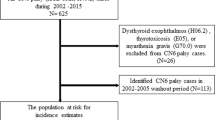Abstract
Purpose
To identify the etiologies of isolated fourth cranial nerve palsy in Ramathibodi hospital, Thailand.
Methods
Patients diagnosed with isolated fourth nerve palsy from January 1, 2009, through July 31, 2020 in Ramathibodi Hospital, were included in this retrospective, observational case series. The demographic data of patients, age at presentation, the etiologies of isolated fourth nerve palsy and neuroimaging results (if indicated) were recorded.
Results
We identified 154 unilateral and 4 bilateral cases of isolated fourth nerve palsy. Mean age at presentation was 38.89 ± 25.71 years old. Most of the unilateral cases were congenital (57.79%), with microvasculopathy (27.92%), intracranial neoplasm (8.44%) and other etiologies. Trauma with closed head injury was the most common etiology of bilateral cases (75%), followed by ruptured arteriovenous malformation (25%). Twenty-one of the 43 (48.84%) patients with microvasculopathy fourth nerve palsy underwent neuroimaging, with normal findings, and all patients’ symptoms resolved within 6 months of symptom onset.
Conclusions
In our series, most of the isolated fourth nerve palsy cases were congenital, followed in frequency by microvasculopathy and intracranial tumor, as in many studies. In cases of microvasculopathy, the clinical signs and symptoms resolved within 6 months in all cases: observation was sufficient, with no necessity for neuroimaging. However, neuroimaging should be considered in cases with atypical presentations, such as headache, periorbital pain, or if there is rapid progression or no recovery.

Similar content being viewed by others
Abbreviations
- AVM:
-
Arteriovenous malformation
References
Bielschowsky A (1935) Lectures on motor anomalies of the eyes. II. Paralysis of individual eye muscles. Arch Ophthalmol. 13:33–59
Von Noorden GK, Murray E, Wong SY (1986) Superior oblique paralysis. A review of 270 cases. Arch Ophthalmol. 104(12):1771–1776
Mollan SP, Edwards JH, Price A et al (2009) Aetiology and outcomes of adult superior oblique palsies: a modern series. Eye (Lond) 23(3):640–644
Keane JR (1993) Fourth nerve palsy: historical review and study of 215 inpatients. Neurology 43(12):2439–2443
Rucker CW (1958) Paralysis of the third, fourth and sixth cranial nerves. Am J Ophthalmol 46:787–794
von Noorden GK, Campos EC (2002) Binocular vision and ocular motility theory and management of strabismus, 6th edn. Mosby, St. Louis, pp 168–210
Berens C, Losey RR, Hardy LH (1927) Routine examinations of the ocular muscles and nonoperative treatment. Am J Ophthalmol 10:910–918
Whelton PK, Williams B (2018) The 2018 European Society of Cardiology/European Society of Hypertension and 2017 American College of Cardiology/American Heart Association blood pressure guidelines: more similar than different. JAMA 320(17):1749–1750
American Diabetes Association (2020) 2 Classification and diagnosis of diabetes: standards of medical care in diabetes–2020. Diabetes Care 43(Suppl 1):S14–S31
Halawani AFM, Alahmari ZS, Asiri DA et al (2019) Diagnosis and management of dyslipidemia. Arch Pharma Pract 10(4):67–70
Dosunmu EO, Hatt SR, Leske DA et al (2018) Incidence and etiology of presumed fourth cranial nerve palsy: a population-based study. Am J Ophthalmol 185:110–114
Ellis FD, Helveston EM (1976) Superior oblique palsy: diagnosis and classification. Int Ophthalmol Clin 16(3):127–135
Akagi T, Miyamoto K, Kashii S et al (2008) Cause and prognosis of neurologically isolated third, fourth, or sixth cranial nerve dysfunction in cases of oculomotor palsy. Jpn J Ophthalmol 52(1):32–35
Rush JA, Younge BR (1981) Paralysis of cranial nerves IV III, and VI. Cause and prognosis in 1000 cases. Arch Ophthalmol. 99:76–79
Elmalem VI, Younge BR, Biousse V et al (2009) Clinical course and prognosis of trochlear nerve schwannomas. Ophthalmology 16(10):2011–2016
Muthukrishnan J, Bharadwaj K, Singh Y (2016) Isolated fourth cranial nerve palsy due to pituitary macroadenoma. Med J Armed Forces India 72(Suppl 1):S67–S69
Pagni CA, Canavero S, Vinci V (1990) Left trochlear nerve palsy, unique symptom of an arachnoid cyst of the quadrigeminal plate. Case report. Acta Neurochir (Wien). 105:147–149
Slavin ML (1987) Isolated trochlear nerve palsy secondary to cavernous sinus meningioma. Am J Ophthalmol 104(4):433–434
Lee SU, Choi JY, Kim HJ et al (2018) Central trochlear palsy as an isolated finding with metastatic tumor. J Clin Neurol 14(2):254–256
Barton JJS (2009) The symptomatic IV nerve palsy. Neuro-Ophthalmol 28:171–178
Lee J, Flynn JT (1985) Bilateral superior oblique palsies. Br J Ophthalmol 69:508–513
Guichen L, Xiaobo Z, Xiuhong G et al (2016) Ocular movement nerve palsy after mild head trauma. World Neurosurg 94:296–302
Funding
No funding was received for conducting this study.
Author information
Authors and Affiliations
Contributions
All authors certify that they have no affiliations with or involvement in any organization or entity with any financial interest or non-financial interest in the subject matter or materials discussed in this manuscript.
Corresponding author
Ethics declarations
Ethics approval
Ethical approval was waived by the Human Research Ethics Committee Faculty of Medicine Ramathibodi Hospital, Mahidol University and adhered to the tenets of the Health Insurance Portability and Accountability Act and the Declaration of Helsinki in view of the retrospective nature of the study and all the procedures being performed were part of the routine care.
Additional information
Publisher's Note
Springer Nature remains neutral with regard to jurisdictional claims in published maps and institutional affiliations.
Rights and permissions
About this article
Cite this article
Lekskul, A., Wuthisiri, W. & Tangtammaruk, P. The etiologies of isolated fourth cranial nerve palsy: a 10-year review of 158 cases. Int Ophthalmol 41, 3437–3442 (2021). https://doi.org/10.1007/s10792-021-01907-w
Received:
Accepted:
Published:
Issue Date:
DOI: https://doi.org/10.1007/s10792-021-01907-w




